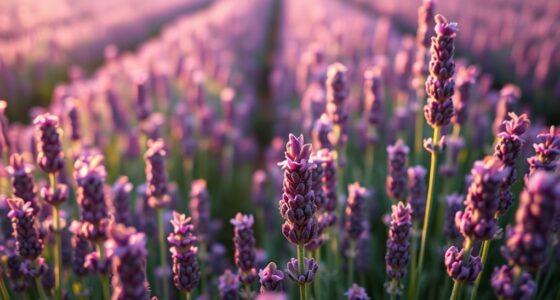Growing lavender in containers on your balcony is a great way to enjoy its beautiful scent close to where you relax. With proper care, like well-draining soil and full sunlight, your lavender will release a calming fragrance whenever you brush past or water it. Keep pests at bay and guarantee good airflow to maintain its health. For tips on keeping your lavender smelling wonderful and thriving in containers, there’s more to discover below.
Key Takeaways
- Growing lavender in containers on balconies enhances the space with natural, calming fragrance.
- Proper container drainage and soil ensure strong, aromatic plants with vibrant scent.
- Regular watering and sunlight boost healthy growth and intensified scent emission.
- Keeping lavender free of pests maintains its aromatic quality and overall health.
- Pruning and good hygiene help preserve the fragrance and prevent pest-related scent issues.

Growing lavender in containers is a simple and rewarding way to enjoy its fragrant blooms and calming aroma anywhere you like. Whether you’re sprucing up your balcony or windowsill, container-grown lavender can transform your space into a fragrant oasis. To keep your lavender thriving, paying attention to its watering schedule is essential. Lavender prefers well-drained soil and doesn’t like to sit in water, so you should water it deeply but infrequently. During warmer months, you might water every few days, ensuring the soil dries out between watering sessions. In cooler weather, reduce watering frequency. Using a container with drainage holes is critical to prevent excess moisture, which can lead to root rot. Always check the top inch of soil; if it feels dry, it’s time to water. Consistency is key, but overwatering can be just as harmful as underwatering. A good rule of thumb is to water when the topsoil feels dry, never on a fixed schedule, as environmental conditions vary. Proper watering practices are vital for maintaining healthy lavender plants.
Pest management is another important aspect of caring for lavender in containers. While lavender is generally pest-resistant, it’s not immune. Common pests like aphids, whiteflies, and spider mites can occasionally trouble your plants, especially if they’re stressed or crowded. To keep pests at bay, regularly inspect your plants and remove any visible insects by hand or with a gentle spray of water. Introducing beneficial insects, like ladybugs, can also help control pest populations naturally. Keep your lavender healthy by ensuring proper watering, adequate sunlight, and good airflow around the plant. Overcrowding in containers can create a humid environment that attracts pests, so ensure your plant isn’t too tightly packed. If you notice signs of pests, treat them promptly with insecticidal soap or neem oil, following product instructions carefully. Regular monitoring and good hygiene are your best defenses against infestations.
Frequently Asked Questions
Can Lavender Thrive in Shaded Balcony Areas?
Lavender struggles to thrive in shaded balcony areas because it prefers full sun for ideal shade tolerance. While it can survive in partial shade, its scent and growth may weaken. To help lavender flourish, guarantee your container has good drainage to prevent root rot. Place it where it gets at least 6 hours of sunlight daily, and consider choosing a sunnier spot if you want a strong scent and healthy plants.
How Often Should I Water Lavender in Containers?
Think of watering lavender like a vintage typewriter—delicate but reliable. You should water your container lavender when the top inch of soil feels dry, usually every 1-2 weeks. Make sure your container has good drainage to prevent overwatering. During hot, dry spells, you might need to water more often, but always avoid soggy soil. Proper watering frequency and drainage keep your lavender healthy and aromatic.
What Are the Best Companion Plants for Lavender?
You should plant lavender alongside pollinator-friendly companions like roses, sage, and marjoram. These plants attract pollinators, enhancing your garden’s health and productivity through companion planting benefits. Lavender’s scent also complements these plants, creating an aromatic, visually appealing space. By pairing lavender with herbs and flowering plants that attract bees and butterflies, you boost pollinator activity and enjoy a thriving, vibrant balcony garden.
How to Prevent Pests on Balcony Lavender Plants?
Imagine your lavender as a peaceful guardian, warding off pests like a gentle breeze. To prevent pests, you should regularly inspect your plants and encourage natural allies like marigolds or basil nearby. Use organic deterrents such as neem oil or insecticidal soap to keep unwanted visitors at bay. These measures create a protective shield, ensuring your lavender remains fragrant and healthy, thriving amidst a pest-free oasis on your balcony.
When Is the Ideal Time to Prune Lavender in Containers?
You should prune your container lavender in late summer or early fall, after the blooming season. Use proper pruning techniques by cutting back about one-third of the plant, focusing on the woody stems. This seasonal timing encourages healthy growth and maintains a compact shape. Regular pruning prevents legginess, promotes new blooms, and keeps your lavender smelling fresh. Remember to use clean, sharp tools to avoid damaging the plant.
Conclusion
Planting lavender in containers on your balcony not only adds a lovely scent but also attracts pollinators like bees and butterflies. Did you know that lavender can boost your mood and reduce stress? With just a few pots, you can enjoy its calming aroma daily. Plus, lavender is drought-tolerant, making it an easy, low-maintenance choice for urban gardeners. So go ahead, brighten your balcony and embrace the soothing power of lavender!









